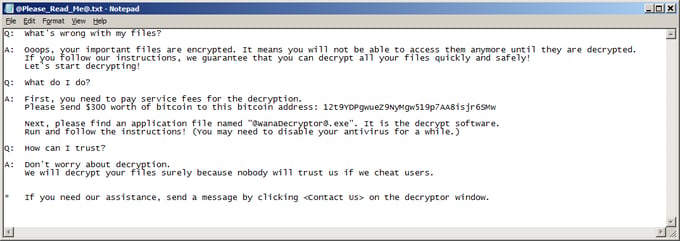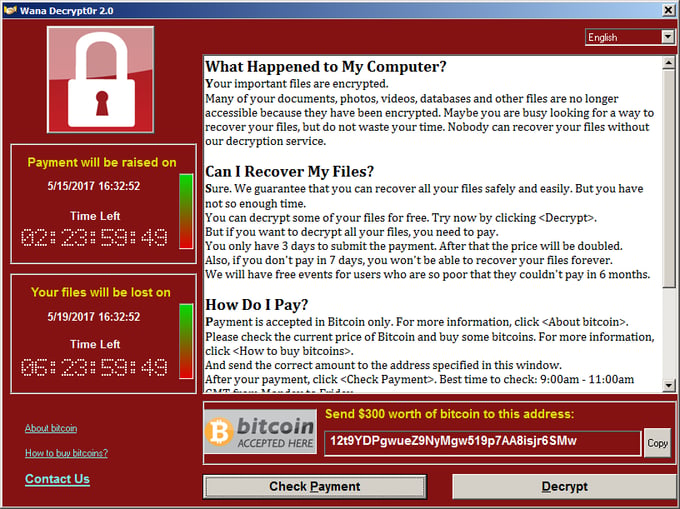Avast protects you from WannaCry ransomware that infected NHS and Telefonica.
Update (4:23 CET, Monday, May 15th): We are now seeing more than 213,000 detections of WannaCry, in 112 countries.
We have observed a massive peak in WannaCry (aka WCry) ransomware attacks today, with more than 57,000 detections, so far. According to our data, the ransomware is mainly being targeted to Russia, Ukraine and Taiwan, but the ransomware has successfully infected major institutions, like hospitals across England and Spanish telecommunications company, Telefonica.
Below is a map showing the countries being targeted most by WannaCry:

We saw the first version of WannaCry in February and now the ransomware is available in 28 different languages, from languages like Bulgarian to Vietnamese. Today at 8 am CET, we noticed an increase in activity of this strain, which quickly escalated into a massive spreading, beginning at 10 am.
The ransomware changes the affected file extension names to “.WNCRY”, so an infected file will look something like: original_name_of_file.jpg.WNCRY, for example. The encrypted files are also marked by the “WANACRY!” string at the beginning of the file.
This ransomware drops the following ransom notes in a text file:

Furthermore, the ransom being demanded is $300 worth of bitcoins. The ransom message, where instructions on how to pay the ransom, an explanation of what happened, and a countdown timer are displayed in what the cybercriminals behind the ransomware are referring to as “Wana Decrypt0r 2.0”:

Additionally, the victim’s wallpaper is changed to the following image:

This attack once again proves that ransomware is a powerful weapon that can be used against consumers and businesses alike. Ransomware becomes particularly nasty when it infects institutions like hospitals, where it can put people’s lives in danger.
Infection vector: WannaCry
WannaCry is most likely spreading on so many computers by using an exploit the Equation Group, which is a group that is widely suspected of being tied to the NSA, used for its dirty business. A hacker group called ShadowBrokers has stolen Equation Group’s hacking tools and has publicly released them. As confirmed by security researcher, Kafeine, the exploit, known as ETERNALBLUE or MS17-010, was probably used by the cybercriminals behind WannaCry and is a Windows SMB (Server Message Block, a network file sharing protocol) vulnerability.
Avast antivirus detects all known versions of WannaCry, but we strongly recommend all Windows users fully update their system with the latest available patches. We will continue to monitor this outbreak and update this blog post when we have further updates.
IOCs:
09a46b3e1be080745a6d8d88d6b5bd351b1c7586ae0dc94d0c238ee36421cafa
24d004a104d4d54034dbcffc2a4b19a11f39008a575aa614ea04703480b1022c
2584e1521065e45ec3c17767c065429038fc6291c091097ea8b22c8a502c41dd
2ca2d550e603d74dedda03156023135b38da3630cb014e3d00b1263358c5f00d
4A468603FDCB7A2EB5770705898CF9EF37AADE532A7964642ECD705A74794B79
B9C5D4339809E0AD9A00D4D3DD26FDF44A32819A54ABF846BB9B560D81391C25
d8a9879a99ac7b12e63e6bcae7f965fbf1b63d892a8649ab1d6b08ce711f7127
ed01ebfbc9eb5bbea545af4d01bf5f1071661840480439c6e5babe8e080e41aa
f8812f1deb8001f3b7672b6fc85640ecb123bc2304b563728e6235ccbe782d85